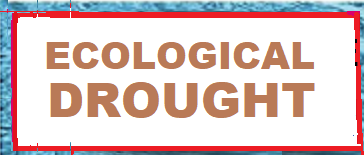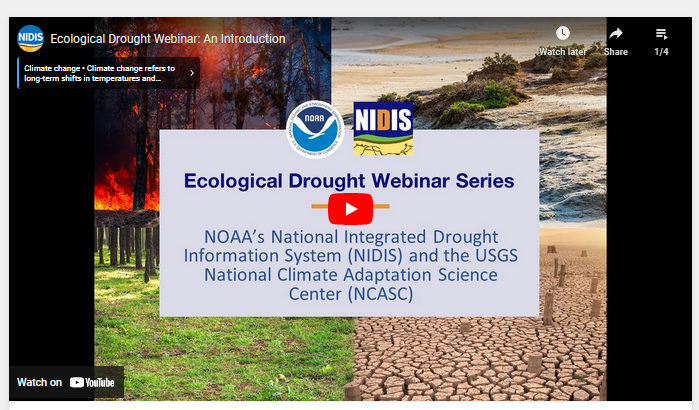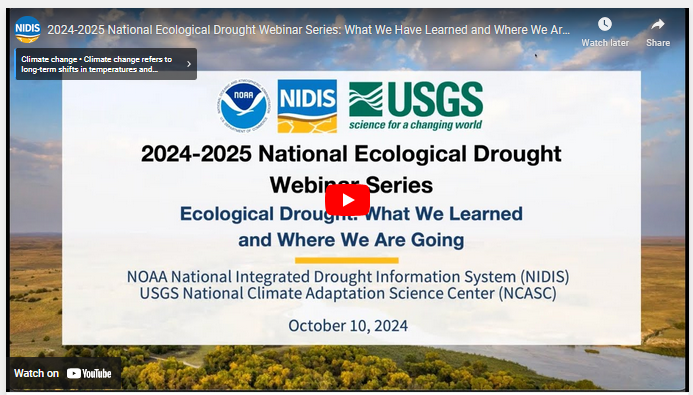

| Drought has traditionally been viewed in terms of its agricultural, hydrological, and socioeconomic impacts. However, this does not fully address the impacts to ecosystems, and the critical services they provide to humans. In 2017, an Ecological Drought Framework was developed by the U.S. Geological Survey in conjunction with the Nature Conservancy and the Wildlife Conservation Society that intentionally considers the interconnectedness of nature and humans. The objective of this framework is to identify drought policy and natural resource management strategies that are mutually beneficial.
The National Integrated Drought Information Center (NIDIS) and the U.S. Geological Survey National Climate Adaptation Science Center (NCASC) co-organized a series of four webinars in early 2021 to raise awareness of ecological drought and share new research and practical actions to strengthen ecosystem resilience to drought. These webinars introduced the ecological drought concept, and explored how to incorporate ecological drought in planning for ecosystem resilience, wildfire management, and vibrant coastal ecosystems. The series included speakers from the research community, tribal nations, and government agencies. |
Remember this is the 2021 Webinar Series. If you want to watch it, click HERE. This will present the above graphic but it will be alive so you can then click on the start arrow. You may have to wait a few seconds and “skip” a commercial to get to the actual presentation.
However, the focus of this article is not the 2021 Webinar Series but the current Webinar Series on ecological drought. It is more than three years later so there has been progress in understanding the causes of and how to deal with ecological drought. There are many different kinds of drought and THIS is a pretty good explanation of the different types. Until recently the different types of drought related almost totally to the direct impact on people. The impact on ecology was almost totally ignored. The webinar series in 2021 was one of the first attempts to consider how drought impacts ecology. The 2024-2025 series of webinars is an attempt to better understand the impact of drought on ecology and the impact of ecology on drought.
Please click on “Read Here” to access the body of this article.
To watch this YouTube click HERE. That will display the above but it will be live and you can then click on the arrow to start the YouTube.
Below is the summary of what is in the set of presentations. I am quoting from the summary of the first Webinar in the Series.
This five-part webinar series seeks to raise awareness of ecological drought, share actions that strengthen ecosystem resilience and mitigate the impacts of droughts, and highlight advancements in integrating interdisciplinary research and management needs for future drought planning and preparedness. The series is co-hosted by the NOAA National Integrated Drought Information System (NIDIS) and the USGS National Climate Adaptation Science Center (NCASC), with expert speakers from the research community, tribal nations, and government agencies. Information shared will build on the NIDIS/NCASC 2021 National Ecological Drought Webinar Series.
–
Welcome and Introductions
Speakers: Meredith Muth, NOAA’s National Integrated Drought Information System (NIDIS); Jackson Valler, USGS National Climate Adaptation Science Center (NCASC)
- This webinar is the first in a five-part webinar series that seeks to raise awareness of ecological drought, share actions that strengthen ecosystem resilience and mitigate the impacts of droughts, and highlight advancements in integrating interdisciplinary research and management needs for future drought planning and preparedness.
- The series was jointly organized by NIDIS and the National CASC—and our speakers are contributing their expertise to meet these webinar goals.
- Information shared will build on the NIDIS/NCASC 2021 National Ecological Drought Webinar Series.
| I hope you found this article interesting and useful. |

